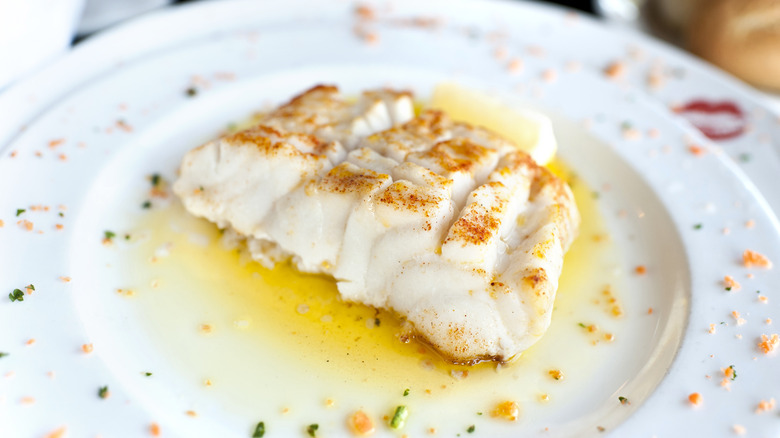The Only Tip You Need To Stop Lemon Butter From Breaking
Lemon butter is an incredibly simple thing, consisting of nothing but lemon juice and melted butter, but making it can be more difficult than you'd expect. This sauce is an example of a culinary emulsion, or a combination of two substances that normally repel each other, such as oil (fat) and vinegar (which is mostly water). In this case, lemon juice and butter are vigorously combined into one smooth substance. Unfortunately, like many emulsified sauces, lemon butter is susceptible to breaking. You could wind up with a sauce that looks visibly separated with pools of fat floating in liquid, like a bottle of Italian salad dressing before you shake it. Not exactly appealing, right?
Even though these two ingredients naturally don't want to mix together, you can coax them into playing nice with a few simple tricks. The single most important thing to remember is that you must simmer your lemon and butter mixture over low heat, as higher temperatures encourage separation. A low simmer is all you need to gently cook the juice and butter together without the butter curdling.
Secondly, use a whisk to combine the mixture, and for the best results, you should also add cold butter slowly to the lemon juice, preferably in smaller chunks so it can disperse more easily and evenly throughout the liquid. Though it may seem easier to melt your butter in the pan first and then stir in the lemon juice, this poses its own set of problems.
The issue with adding lemon juice to butter
Although you may not think there's no problem with adding lemon juice to butter, instead of the other way around, basic food science says otherwise. If you start your lemon butter by melting the butter first, it could easily get too hot and curdle before you even add the lemon. Again, low heat must be used the entire time you're making the sauce. Even if the butter doesn't curdle, adding uncooked lemon juice directly to the melted fat can be too acidic for the butter to handle, breaking the sauce.
This is why you're better off starting with lemon juice in the pan. It gives the acids in the lemon juice time to reduce and provides stability for your emulsion when you eventually add the butter. Using cold butter rather than melted butter also helps to lower the temperature of the sauce, and we've already established that lower cooking temperatures are ideal for gradual and stable emulsification. Be patient and you'll have a deliciously rich yet tangy sauce that's perfect for steak, chicken, veggies, and more.
What to do if your lemon butter is still separating
Now you know what to do to avoid a watery sauce with blobs of visible fat in the pan. That being said, cooking can be unpredictable, so if your sauce has started to break, use these tips to save it from further separation.
One method entails adding more of your liquid –- in this case, lemon juice -– to the pan. A mere tablespoon should be enough to smooth out any buttery lumps and lower the sauce's temperature so it doesn't fully curdle. You can add more juice as necessary until the sauce comes back together, but be careful not to overdo it. Don't try to tackle the problem by adding more butter, as that will make the separation even worse. Another quick fix for a broken sauce is to give it a second mixing with your whisk. As mentioned previously, whisking the sauce vigorously helps the ingredients combine most effectively.



